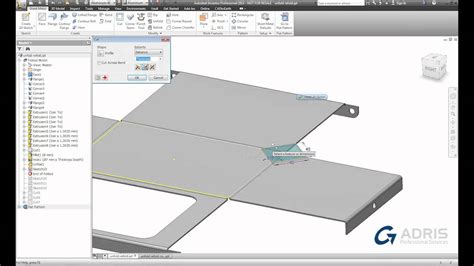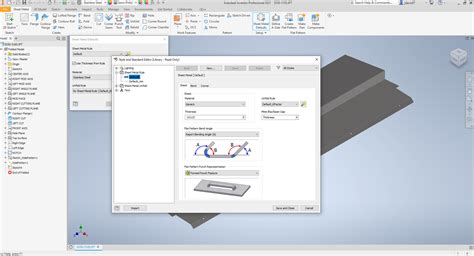convert part to sheet metal inventor To convert a standard Inventor part to a sheet metal part use the Convert to . Metal boxes are generally steel, while plastic boxes are PVC or fiberglass. Metal Electrical Boxes . Metal electrical boxes are best for metal-sheathed cable or metal conduit. Weatherproof metal boxes for outdoor use are generally made of aluminum. Capable of being grounded; Durable; Fireproof; Secure; Required with metal conduit; Plastic .
0 · inventor unfold sheet metal
1 · inventor sheet metal defaults
2 · inventor change sheet metal thickness
3 · converting a part to sheet metal
4 · autodesk inventor sheet metal tutorial
5 · autodesk inventor sheet metal
6 · autocad inventor to sheet metal
7 · autocad inventor sheet metal conversion
The big heap of rolling steel is a Renault Trafic van, with some pretty serious rust destroying some box sections of chassis at the rear where the leaf spring bolts to. I measured a piece of the existing metal, and its is around 1.2mm thick.
Time to get familiar with sheet metal environment - it is easy. My part - your part. Notice the transitions. There are two different methods using Lofted Flange - Die Formed and Press Brake Formed. Try both and use the one that will actually be used to manufacture the part.

metal cap fabrication salem
To convert a standard Inventor part to a sheet metal part use the Convert to .Create a regular part with a uniform thickness, and then convert it to a sheet .TruNest accepts Inventor files as input, and expects them to be sheet metal flat parts .

inventor unfold sheet metal
Short overview of how to convert a standard part to sheet metal in Autodesk Inventor, so it can be unfolded as well. .more. For consultation regarding Autodesk Inventor, please. Autodesk® Inventor® has tools for creating sheet metal-specific features that follow a manufacturing standard, ensuring your ability to flatten your 3D model.
I'm wondering if there is an easy way to convert this standard Inventor 2015 part to a sheet metal part so I can create a flat pattern. I've had some light sheet metal training years . converts solid parts to sheet metal parts in a single click. However, you can achieve this by following a manual process. Here are the general steps to conve. Learn how to convert parts into sheet metal designs and flatten them accurately using Autodesk Inventor. Discover the process step-by-step. To convert a standard Inventor part to a sheet metal part use the Convert to Sheet Metal function, available in the 3D Model tab. When converting, Inventor will ask to select the .
inventor sheet metal defaults
inventor change sheet metal thickness
Create a regular part with a uniform thickness, and then convert it to a sheet metal part. Specifying a part as sheet metal displays the Sheet Metal tab, and adds sheet metal-specific .

TruNest accepts Inventor files as input, and expects them to be sheet metal flat parts (I think). We exported our Fusion file to Inventor (using Autodesk Cloud). Then the .
Time to get familiar with sheet metal environment - it is easy. My part - your part. Notice the transitions. There are two different methods using Lofted Flange - Die Formed and Press Brake Formed. Try both and use the one that will actually be used to manufacture the part.
Short overview of how to convert a standard part to sheet metal in Autodesk Inventor, so it can be unfolded as well. .more. For consultation regarding Autodesk Inventor, please. Autodesk® Inventor® has tools for creating sheet metal-specific features that follow a manufacturing standard, ensuring your ability to flatten your 3D model. I'm wondering if there is an easy way to convert this standard Inventor 2015 part to a sheet metal part so I can create a flat pattern. I've had some light sheet metal training years ago, mostly unused and forgotten. The part was created from a thickened surface quilt in a multibody solid. Autodesk Inventor allows for converting models to sheet metal. Which means, regardless where the model geometry originates, you can convert it to sheet metal, add sheet metal features, and generate the flat pattern.
converts solid parts to sheet metal parts in a single click. However, you can achieve this by following a manual process. Here are the general steps to conve. Learn how to convert parts into sheet metal designs and flatten them accurately using Autodesk Inventor. Discover the process step-by-step.
To convert a standard Inventor part to a sheet metal part use the Convert to Sheet Metal function, available in the 3D Model tab. When converting, Inventor will ask to select the base face. Inventor should then recognize the thickness of the component.Create a regular part with a uniform thickness, and then convert it to a sheet metal part. Specifying a part as sheet metal displays the Sheet Metal tab, and adds sheet metal-specific parameters to the parameters list. Conversely, you can .
TruNest accepts Inventor files as input, and expects them to be sheet metal flat parts (I think). We exported our Fusion file to Inventor (using Autodesk Cloud). Then the following script is meant convert each part from a solid part to a . Time to get familiar with sheet metal environment - it is easy. My part - your part. Notice the transitions. There are two different methods using Lofted Flange - Die Formed and Press Brake Formed. Try both and use the one that will actually be used to manufacture the part. Short overview of how to convert a standard part to sheet metal in Autodesk Inventor, so it can be unfolded as well. .more. For consultation regarding Autodesk Inventor, please.
Autodesk® Inventor® has tools for creating sheet metal-specific features that follow a manufacturing standard, ensuring your ability to flatten your 3D model.
converting a part to sheet metal
I'm wondering if there is an easy way to convert this standard Inventor 2015 part to a sheet metal part so I can create a flat pattern. I've had some light sheet metal training years ago, mostly unused and forgotten. The part was created from a thickened surface quilt in a multibody solid. Autodesk Inventor allows for converting models to sheet metal. Which means, regardless where the model geometry originates, you can convert it to sheet metal, add sheet metal features, and generate the flat pattern. converts solid parts to sheet metal parts in a single click. However, you can achieve this by following a manual process. Here are the general steps to conve. Learn how to convert parts into sheet metal designs and flatten them accurately using Autodesk Inventor. Discover the process step-by-step.
To convert a standard Inventor part to a sheet metal part use the Convert to Sheet Metal function, available in the 3D Model tab. When converting, Inventor will ask to select the base face. Inventor should then recognize the thickness of the component.
Create a regular part with a uniform thickness, and then convert it to a sheet metal part. Specifying a part as sheet metal displays the Sheet Metal tab, and adds sheet metal-specific parameters to the parameters list. Conversely, you can .
autodesk inventor sheet metal tutorial
When selecting the appropriate screw length for a junction box, consider the depth of the box and the thickness of the wall or mounting surface. For standard junction boxes, a screw length of 1 to 2 inches is typically sufficient.
convert part to sheet metal inventor|autocad inventor to sheet metal